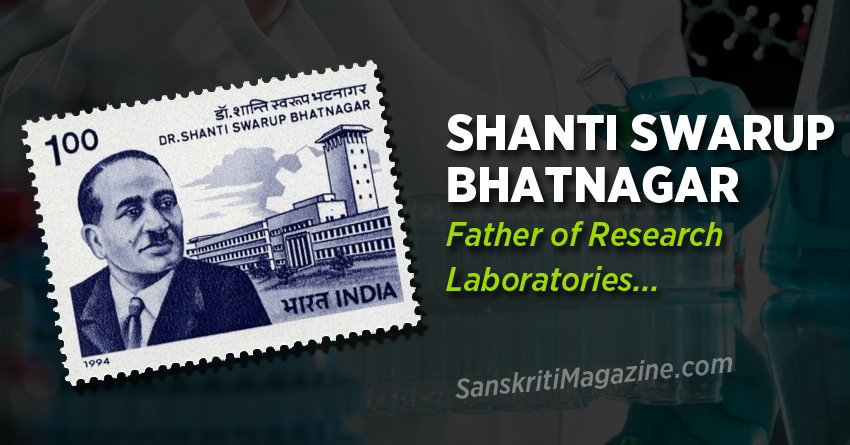“I can truly say that for Dr. Bhatnagar you could not have seen today the chain of national laboratories.”
– Jawaharlal Nehru
Shanti Swarup Bhatnagar along with Bhabha, Mahalanobis and Sarabhai played a key role in building India’s scientific infrastructure after independence. Bhatnagar apart from being an eminent scientist also created institutions which became a ‘cradle’ for nurturing science in India. He showed that science becomes relevant to society when scientists translate it into applications and use it to solve practical problems.
Bhatnagar was born on 21 February 1894, at Bhera, in the District of Shahpur (now in Pakistan). His father, a graduate of the Punjab University, was a man of progressive ideas and rose to become the headmaster of the local high-school. Unfortunately, he died when Shanti Swarup was just eight months old. This left the family in dire poverty. The young Bhatnagar was brought up by his maternal grandfather Pearey Lal – a distinguished engineer from the Roorkee College of Engineering. Shanti Swarup de veloped a taste for science from an early age. He would assemble mechanical toys and tinker around with his grandfather’s gadgets. Here he was also exposed to good Urdu poetry and literature.
Shanti Swarup had his earliest schooling in a private maktab. Until 1907, he studied at the A. V. High School in Sikandarabad, UP. He was later persuaded by a family friend to move to Lahore where he attended the Dayal Singh High School. Here he excelled in both science and Urdu. In 1911, at the age of 17 he published his first paper in Leader published from Allahabad, on a method of making substitute carbon electrodes for a battery by heating molasses and carbonaceous matter under pressure.
In 1916, Shanti Swarup completed BSc in physics from the Forman Christian College, Lahore. In 1919, he finished MSc in chemistry from the same college. It seemed the system of education was more flexible then. A graduate student in those days could switch from physics to chemistry; a feat impossible to imagine today! With a scholarship from the Dayal Singh College for higher studies, Bhatnagar left for America via England. But since this was during the First World War, he found it difficult to get a ship for America, so he decided to stay back in England. He joined the University College, London and worked under Prof. F. G. Donnan – a distinguished physical chemist. He was awarded a DSc degree in 1921 for his thesis On solubility of bivalent and trivalent salts of higher fatty acids in oils and their effect on the surface tension of oils.
Bhatnagar returned to India in August 1921 and he joined the Banaras Hindu University (BHU) as Professor of Chemistry. During his short three years stay at BHU he created an active school of chemical research. He also penned the ceremonial Hindi hymn (Kulgeet) of the BHU. In 1924 he moved to Punjab University, Lahore as the Director of the University Chemical Laboratories where he stayed on until 1940. In these 16 years he published over a 100 papers. This was perhaps the most active period of his original scientific research. Apart from contributing to the field of colloidal and magneto-chemistry he also solved many practical industrial problems. For instance, while drilling for oil, the Attock Oil Company found that the drills got stuck in mud and saline water. Bhatnagar solved this ingeniously by adding Indian gum which lowered the viscosity of the mud suspension.
The company was so thrilled by this practical research that they offered Bhatnagar a sum of Rs. 1, 50,000/- for R&D in 1925!
Bhatnagar used this money to set up the Department of Petroleum Research at the Punjab University. During the next ten years Bhatnagar and his students did pioneering research on waxes, increasing the flame height of kerosene, lubrication, corrosion prevention etc. Several patents were licensed and granted. Fifty percent of all royalty proceeds were used by the University to fund scientific research. Bhatnagar combined pioneering basic research with practical problem solving as they were the two sides of the same coin. He created wealth out of knowledge, recognizing the value of intellectual property long before it gained currency.
In the 1930s there were no research labs for the de velopment of India’s natural resources and industry. Just before the outbreak of the Second World War the Government of India established the Board of Scientific and Industrial Research. In December 1939, Bhatnagar was appointed as Advisor on Scientific and Industrial Research to the Government of India. Thus began his fifteen year long association with the Council of Scientific & Industrial Research (CSIR) established on 26 September 1942.
Bhatnagar created a clear blue print for the CSIR. Old timers recall with a chuckle how Bhatnagar would meet Nehru during the latter’s morning walk, get approval for a new laboratory and have the paperwork ready by the time the office opened! It is to the credit of Bhatnagar that at the time of his demise 12 national labs were already functional – which included big institutions like the National Chemical Laboratory in Pune and the National Physical Laboratory in Delhi. He set up the Indian Rare Earths Ltd to exploit the rich monazite sands of Kerala. He was also instrumental in setting up several private sector oil refineries. Bhatnagar held many high offices. He was the Secretary of the Atomic Energy Commission; Director, Council of Scientific and Industrial Research and Chairman, University Grants Commission. Many honours came his way, some significant ones being the Order of the British Empire (OBE) in 1936, Knighthood in 1941, Fellowship of the Royal Society in 1943 and several honorary degrees.
Bhatnagar was greatly influenced by the Brahmo Samaj in his formative years. He was deeply attached to his wife Lajwanti. A romantic at heart, he nursed the hope of becoming a farmer after retirement – and the hope that his wife would bring him lunch and a pot of butter milk in the fields!
He died of a heart attack on 1 January 1955. Bhatnagar achieved a great deal in his eventful sixty years. He left an indelible imprint on pure science. He believed in the application of science to help solve the country’s economic problems. As a visionary he saw the need for a strong science infrastructure for an independent India. The CSIR seed sown by him has slowly grown into a giant tree. Today the 38 CSIR labs conducting research in widely diverse areas as Aerospace, Biotechnology and Chemistry… virtually constitute the ABC of Indian science.
~ Arvind Gupta, the Author is an Indian toy inventor and popularizer of science.











